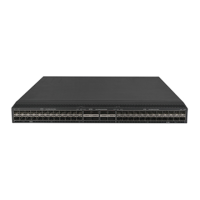35
Configuring edge ports
About edge port
If a port directly connects to a user terminal rather than another device or a shared LAN segment,
this port is regarded as an edge port. When network topology change occurs, an edge port will not
cause a temporary loop. Because a device does not determine whether a port is directly connected
to a terminal, you must manually configure the port as an edge port. After that, the port can rapidly
transit from the blocking state to the forwarding state.
Restrictions and guidelines
• If BPDU guard is disabled on a port configured as an edge port, the port becomes a non-edge
port again if it receives a BPDU from another port. To restore the edge port, re-enable it.
• If a port directly connects to a user terminal, configure it as an edge port and enable BPDU
guard for it. This enables the port to quickly transit to the forwarding state when ensuring
network security.
• On a port, the loop guard feature and the edge port setting are mutually exclusive.
Procedure
1. Enter system view.
system-view
2. Enter interface view.
interface interface-type interface-number
3. Configure the port as an edge port.
stp edged-port
By default, all ports are non-edge ports.
Configuring path costs of ports
About path cost
Path cost is a parameter related to the link speed of a port. On a spanning tree device, a port can
have different path costs in different MSTIs. Setting appropriate path costs allows VLAN traffic flows
to be forwarded along different physical links, achieving VLAN-based load balancing.
You can have the device automatically calculate the default path cost, or you can configure the path
cost for ports.
Specifying a standard for the default path cost calculation
About the standard for the default path cost calculation
You can specify a standard for the device to use in automatic calculation for the default path cost.
The device supports the following standards:
• dot1d-1998—The device calculates the default path cost for ports based on IEEE 802.1d-1998.
• dot1t—The device calculates the default path cost for ports based on IEEE 802.1t.
• legacy—The device calculates the default path cost for ports based on a private standard.

